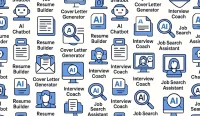The United States job market has become increasingly challenging for international students, with recent reports showing a staggering 172,000 job cuts announced—a more than 100% increase over the previous month. If you’re planning to study in the US for Fall 2025, understanding this harsh reality before making such a significant investment is crucial for your future success and mental wellbeing.
The Brutal Truth About Today’s US Job Market for International Students
The United States has long been a dream destination for international students seeking quality education and career opportunities. However, the landscape has dramatically shifted in recent years. With federal layoffs hitting hard and companies changing their hiring policies for international candidates, the job market reality has become increasingly challenging.
If you’re planning to study in the US for Fall 2025, it’s essential to approach this decision with complete awareness rather than idealized expectations. This isn’t meant to discourage you but to prepare you for the realities that many current international students are facing.
Unlike what consultancies in India might tell you or what universities marketing to international students might suggest, coming to the United States is no longer a guaranteed path to career success. Universities often view international students as “cash cows” who pay $50,000-$100,000 in tuition, while consultancies earn commissions by sending students abroad regardless of their prospects.
The harsh truth is that many international students are returning to their home countries with $50,000-$100,000 in debt and no job prospects. Others remain in the US, working unpaid internships or volunteer positions while asking their parents for money to survive—a situation that takes a tremendous toll on their mental health.
Recent Job Market Statistics That Should Concern You
The US Labor Department recently released jobless claim numbers that paint a concerning picture for job seekers. With a more than 100% increase in job cuts over the previous month, competition for available positions has intensified dramatically. For international students who face additional hurdles due to visa restrictions, this means an even more challenging path to employment.
According to recent Bureau of Labor Statistics data, job openings have decreased significantly in many sectors popular among international students, including technology, finance, and consulting. This contraction has led to longer job searches, more competition, and increased selectivity from employers.
The Hidden Struggles of International Students in the Current Job Market
Real Stories from Current Students
Many international students currently in the US are facing unprecedented challenges in securing employment. In job hunting communities, students regularly share their struggles:
- “My OPT is ending in June, and after almost a year of job searching, I’m considering joining a consultancy for my STEM extension.”
- “After a year and a half of searching, I’ve had no luck finding employment.”
- “I attended a university career fair and interacted with 5-6 companies. Four of them explicitly said they couldn’t hire international students despite liking my skills.”
- “I’m graduating this May and feeling depressed because I have no options.”
These aren’t isolated cases. Even students from prestigious institutions like Cornell University and Carnegie Mellon University with 3+ years of work experience are struggling to secure interviews. If students from these top-tier universities are facing difficulties, the situation is even more challenging for those from less recognized institutions.
Changing Employer Attitudes Toward International Students
Companies are increasingly modifying their hiring practices in ways that disadvantage international students. Previously, job applications would ask if candidates would require sponsorship “now or in the future” (covering both OPT and H-1B visas). Now, many applications specifically ask if candidates require any support for CPT internships, OPT, or H-1B visas.
Marking “yes” to these questions often triggers automatic rejection, regardless of qualifications. This practice has become more common as companies seek to simplify their hiring processes and reduce uncertainty related to international candidates.
According to the Society for Human Resource Management, many employers are hesitant to hire international students due to perceived complexity and uncertainty around immigration processes, even when these perceptions don’t match reality.
🌍 Hiring? Connect with Qualified International Talent
Are you an employer looking to diversify your workforce with global perspectives and specialized skills? International candidates bring multilingual abilities, cross-cultural insight, and innovative thinking to your team.
Post your job openings for free on WhatJobs and connect with highly motivated international professionals who can elevate your organization’s global potential.
🌐 Post Jobs & Reach Global TalentEssential Preparation for Success in the US as an International Student
Start Your Job Hunt Before You Arrive
If you’re planning to start your studies in Fall 2025, you need to begin preparing for your job search immediately. Many students make the critical mistake of waiting until they arrive in the US to start thinking about internships and employment. By then, it’s often too late.
The peak hiring season for summer internships begins just 15 days after most Fall semester students arrive in August. Without a polished resume, optimized LinkedIn profile, professional portfolio, and job search strategy already in place, you’ll likely miss this crucial hiring window.
To avoid this common pitfall:
- Create a detailed roadmap for securing internships and eventual full-time employment
- Develop your resume and LinkedIn profile now, not after arriving
- Research target companies and their hiring cycles
- Build a portfolio showcasing your skills and projects
- Connect with alumni from your prospective university who are working in your field
- Join professional communities in your industry to start networking early
Explore international job opportunities on WhatJobs to understand the market and requirements before making your move.
The Critical Importance of Work Experience
One of the most significant factors affecting job prospects for international students is prior work experience. Students with zero work experience face the steepest challenges in today’s competitive market. Even those from top universities like Cornell and Carnegie Mellon with three years of experience are struggling to secure interviews.
If possible, gain 2-3 years of relevant work experience in your home country before pursuing a US degree. This experience provides several advantages:
- Clearer understanding of your career direction and goals
- Practical skills that complement academic knowledge
- Demonstrable track record for potential employers
- Professional references and an established network
- Greater confidence during interviews and networking events
While there are exceptions—some students with no prior experience do secure positions at companies like Meta or in data science roles—these are increasingly rare cases. The placement rate for international students has dropped significantly, with many universities seeing rates fall from 50-60% to 25-30% or lower.
Making Smart Program and University Choices
Beware of “Cash Cow” Programs
Not all master’s programs offer equal value or employment prospects. Some programs, particularly Masters in Information Management (MIM) and similar “mini-MBA” offerings, are specifically designed to attract international students with limited work experience who might not qualify for traditional MBA programs.
These programs often promise business credentials without requiring significant work experience, but graduates frequently struggle to compete against candidates with traditional MBAs or relevant work history. Employers typically prefer candidates with demonstrated experience in similar roles rather than those with only theoretical knowledge.
Before committing to any program:
- Speak with current students and recent alumni about their job search experiences
- Research employment outcomes specifically for international students in the program
- Ask for data on placement rates, average time to employment, and average starting salaries
- Investigate which companies have hired international graduates from the program
- Consider whether the program includes internship or co-op opportunities
Financial Considerations and University Selection
The financial burden of studying in the US significantly impacts your job search experience and mental health. An $80,000 debt creates immense pressure that affects every aspect of your job hunt, while graduating with little or no debt provides greater flexibility and reduced stress.
Consider universities that offer:
- Lower tuition costs (e.g., Purdue University, Oklahoma State University, Ohio State University)
- Strong co-op programs that allow you to earn while studying
- Scholarships specifically for international students
- Better career services and job placement support
When attending university information sessions, ask pointed questions about how they specifically help international students find jobs and internships. If they can’t provide clear answers or specific data about international student outcomes, consider it a red flag.
Find opportunities in education and university settings on WhatJobs
Maximizing Your Location Advantage
Strategic Networking Beyond Your Campus
Your university’s location significantly impacts your networking opportunities, but what matters more is how you leverage that location. Many students in prime locations like New York, Boston, Chicago, or San Francisco fail to take advantage of their proximity to industry hubs, remaining isolated in their apartments and comfort zones.
Even if your university isn’t in a major city, you can still access valuable networking opportunities:
- Organize group trips to nearby tech hubs or financial centers (e.g., Chico State students can reach San Francisco in a 3-hour drive)
- Plan strategic visits to attend industry conferences, hackathons, and networking events
- Join professional organizations that host regional events
- Connect with alumni working in desired locations
- Participate in virtual networking events with companies in target cities
Rather than complaining about your university’s location, take proactive steps to expand your network beyond campus. These networking investments often yield better returns than paying premium tuition for a university in a better location but not utilizing those advantages.
The Impact of Your Peer Group
The quality and motivation of your peer group significantly influences your job search success. Some universities have expanded their international student cohorts dramatically—from 50 to 500 students—often through partnerships with consultancies that receive commissions for each student placed.
This rapid expansion has sometimes led to a decline in the overall quality and motivation of the student cohort. When selecting a university, research the composition and outcomes of recent graduating classes, particularly for international students in your intended program.
Regardless of where you study, surround yourself with motivated peers who share your commitment to professional success. Form study groups, job search accountability partnerships, and networking circles with ambitious classmates who push you to excel.
FAQ: US Job Market Reality for International Students
How has the US job market changed for international students in recent years?
The US job market reality for international students has transformed dramatically in recent years, creating unprecedented challenges for those seeking post-graduation employment. Previously, international graduates with strong academic credentials from reputable universities could reasonably expect to secure employment opportunities, particularly in STEM fields. Today, even students from prestigious institutions like Cornell and Carnegie Mellon with substantial work experience struggle to receive interview invitations. Companies have modified their application processes to specifically identify and often automatically reject candidates requiring any immigration support, including CPT internships and OPT work authorization.
What specific preparation should international students complete before arriving for Fall 2025?
International students planning to begin studies in Fall 2025 must complete extensive preparation before arriving in the US to navigate the harsh US job market reality effectively. First, develop a comprehensive job search strategy and timeline, recognizing that the peak hiring season for summer internships begins just 15 days after arrival in August. Create a polished, ATS-optimized resume tailored to American expectations, with achievements quantified and relevant keywords incorporated. Build a professional LinkedIn profile with a strong headline, compelling summary, detailed experience sections, and a professional photo. Develop a portfolio showcasing relevant projects, particularly for technical or creative fields. Research target companies thoroughly, including their hiring cycles, application processes, and history of sponsoring international students.
Why is prior work experience so critical for international students in the current US job market?
Prior work experience has become critically important for international students facing the harsh US job market reality because it addresses several key challenges unique to their situation. First, work experience provides tangible evidence that a candidate can perform in a professional environment, reducing the perceived risk for employers already hesitant about immigration complexities. In today’s competitive market, companies receive hundreds of applications for each position and use work experience as a primary filter—international students without experience are often eliminated in the first screening round. Second, experienced candidates demonstrate familiarity with industry-specific tools, methodologies, and business practices, allowing them to become productive more quickly than those requiring extensive training. Third, previous work experience helps international students develop clearer career goals and professional identities, enabling more focused and compelling job applications. Fourth, experienced professionals bring established networks and references that can provide crucial endorsements during the hiring process. Finally, the limited duration of OPT (12 months for most fields, 36 months for STEM) means international students face tight timelines to prove their value—prior experience helps them contribute meaningfully from day one, improving their chances of H-1B sponsorship.
How should international students evaluate potential universities and programs for the best employment outcomes?
When evaluating universities and programs amid the current US job market reality for international students, prospective students should conduct thorough research beyond marketing materials and rankings. Start by examining program-specific employment data for international students—not overall employment statistics that may primarily reflect outcomes for domestic students. Request detailed information about placement rates, average time to employment, salary ranges, and specific employers hiring international graduates from your target program. Speak directly with current international students and recent alumni about their job search experiences, challenges faced, and support received. Evaluate the university’s career services specifically for international students, including dedicated advisors familiar with visa regulations, targeted recruiting events, and relationships with international-student-friendly employers. Assess the program’s curriculum for practical components like co-ops, internships, capstone projects with industry partners, and experiential learning opportunities that build employable skills and U.S. work experience. Consider the university’s location and proximity to relevant industry hubs, but also investigate how the school facilitates connections to employers in distant locations.
What strategies can international students use to maximize their chances of securing employment despite the challenging market?
International students can maximize their employment prospects in the challenging US job market reality by implementing several strategic approaches. First, target companies with established histories of hiring international employees, particularly larger organizations with dedicated international recruitment programs and the resources to navigate immigration processes. Develop specialized, high-demand technical skills that create significant value and help overcome the “sponsorship barrier”—focus on areas with persistent talent shortages like specialized programming languages, AI/ML expertise, or specific industry certifications. Build a robust professional network through consistent participation in industry events, professional organizations, alumni connections, and informational interviews, as many opportunities for international students come through personal referrals rather than application systems. Consider strategic geographic flexibility by focusing on emerging tech hubs or regions with fewer international applicants but growing demand for specialized skills.
Conclusion: Come Prepared or Reconsider Your Timeline
The decision to pursue education in the United States should be made with complete awareness of the current job market challenges. This isn’t about discouraging international students from coming to the US, but rather ensuring they arrive fully prepared for the realities they’ll face.
If your goal is simply to experience American education and return to your home country, these job market concerns may not apply to you. However, if you’re investing $50,000-$100,000 with the expectation of building a career in the United States, you need to approach this decision strategically.
Consider these final recommendations:
- If possible, gain 2-3 years of relevant work experience before coming to the US
- Research universities based on their actual placement rates for international students, not just their brand name
- Develop a comprehensive job search strategy before arriving in the US
- Build your professional network starting now, not after you arrive
- Consider the financial implications carefully and choose programs with reasonable costs
- Surround yourself with motivated peers who share your professional ambitions
With proper preparation and realistic expectations, you can navigate the challenging US job market successfully. The key is to start preparing now, work diligently throughout your program, and remain persistent in the face of obstacles.




